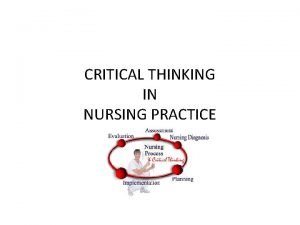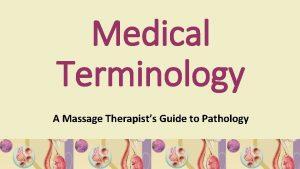A Massage Therapists Guide to Pathology Critical Thinking

































- Slides: 33

A Massage Therapist’s Guide to Pathology: Critical Thinking, Practical Application Chapter 12 Principles of Cancer Copyright © 2014 Wolters Kluwer • All Rights Reserved

Principles of Cancer • 100+ different diseases • Normal cells mutate, replicate uncontrollably • From epithelium = carcinoma • From muscle or connective tissue = sarcoma • From blood or lymph = hematologic cancer “Skilled massage therapy is safe for people with cancer and will not spread the disease. Specific massage adjustments are based on clinical presentations of cancer, not the presence of a cancer diagnosis. ” ~~Tracy Walton • For more on the author’s point of view, see video at the. Point A Massage Therapist's Guide to Pathology Chapter 12: Principles of Cancer Copyright © 2016 Wolters Kluwer • All Rights Reserved 2

Cancer Statistics • #2 cause of death in the US • A man’s lifetime chance = 1: 2, A woman’s lifetime chance = 1: 3 • Usually in people over 55 • 1. 7 million cases diagnosed/year • Doesn’t include non-melanoma skin cancer, anything found in situ • 585, 000 deaths/year = 1, 600/day • Survival rate is improving • Better screening • Better treatment options A Massage Therapist's Guide to Pathology Chapter 12: Principles of Cancer Copyright © 2016 Wolters Kluwer • All Rights Reserved 3

Cancer Statistics • 13. 7 million in US have a history of cancer • Most common diagnosis = non-melanoma skin cancer • Most common cause of death = lung cancer (men + women) • Then… – Breast, ovarian for women – Prostate for men – Colon, rectum for both A Massage Therapist's Guide to Pathology Chapter 12: Principles of Cancer Copyright © 2016 Wolters Kluwer • All Rights Reserved 4

Steps in Metastasis • One thing all cancers have in common is that the DNA of a cell mutates so that the cell acquires certain growth properties. • Oncogene activation • Local invasion • Proliferation • Angiogenesis • Migration • Colonization A Massage Therapist's Guide to Pathology Chapter 12: Principles of Cancer Copyright © 2016 Wolters Kluwer • All Rights Reserved 5

Steps in Metastasis – Oncogene Activation • Oncogene – a gene that initiates malignant characteristics within a cell. These are typically inhibited by the activity of tumor suppressor genes. • Oncogene activation is the beginning of the changes that cause certain cells to become malignant • Trigger may be: • environment exposures • diet • genetic • a combination of factors A Massage Therapist's Guide to Pathology Chapter 12: Principles of Cancer Copyright © 2016 Wolters Kluwer • All Rights Reserved 6

Steps in Metastasis – Local Invasion • Mutated cells invade healthy tissue • May do this without creating an inflammatory response because they secrete chemicals that suppress the immune systems reactions against them A Massage Therapist's Guide to Pathology Chapter 12: Principles of Cancer Copyright © 2016 Wolters Kluwer • All Rights Reserved 7

Steps in Metastasis – Proliferation • Mutated cells proliferate (multiply) creating distinct and disorganized masses called tumors • They lose the characteristics that define their tissue type A Massage Therapist's Guide to Pathology Chapter 12: Principles of Cancer Copyright © 2016 Wolters Kluwer • All Rights Reserved 8

Steps in Metastasis – Angiogenesis • Growth of blood vessels to supply a tumor • Any growth of more than 1 -2 cm requires a dedicated blood supply • The more blood vessels within a tumor, the more likely it is to have metastasized A Massage Therapist's Guide to Pathology Chapter 12: Principles of Cancer Copyright © 2016 Wolters Kluwer • All Rights Reserved 9

Steps in Metastasis – Migration • Cancer cells break off the primary tumor and travel to new areas • May be spread via: • Circulatory system • Lymphatic system • Direct contact with other organs • Peritoneal fluid A Massage Therapist's Guide to Pathology Chapter 12: Principles of Cancer Copyright © 2016 Wolters Kluwer • All Rights Reserved 10

Steps in Metastasis – Colonization • When cancer cells land in a new target tissue, they must begin the entire process over • Requires that the cells be able to: • Adhere to the new tissue • Secrete the correct enzymes to suppress an immune system attack • Create new blood vessels • Erode the new extracellular matrix • Primary tumor – first tumor • Secondary tumor – tumors which grow from the primary tumor A Massage Therapist's Guide to Pathology Chapter 12: Principles of Cancer Copyright © 2016 Wolters Kluwer • All Rights Reserved 11

Causes of Cancer: Internal Factors • Inhibited apoptosis • Inherited gene • Could be for a cancer type (breast, colorectal) • Could be for a reaction to an environmental trigger • Hormonal activity • Immune system problems A Massage Therapist's Guide to Pathology Chapter 12: Principles of Cancer Copyright © 2016 Wolters Kluwer • All Rights Reserved 12

Causes of Cancer: External Factors • Environmental carcinogens • Viruses • Bacteria • Animal parasites A Massage Therapist's Guide to Pathology Chapter 12: Principles of Cancer Copyright © 2016 Wolters Kluwer • All Rights Reserved 13

Environmental Carcinogens • 240 known carcinogens • • • Hydrocarbons in cigarette smoke Compounds from grilling meat Chemicals from ink, dye, paint Radiation Asbestos Benzene Nickel Cadmium Etc… A Massage Therapist's Guide to Pathology Chapter 12: Principles of Cancer Copyright © 2016 Wolters Kluwer • All Rights Reserved 14

Viruses Associated With Cancer Risk • Human T-cell lymphotropic virus-1 (HTLV-1), similar to HIV • Lymphocytic leukemia, Hodgkin lymphoma • Human papilloma virus • Cancer of the cervix, penis, anus, vagina, vulva, mouth, throat • Human herpesvirus 8 • Kaposi sarcoma • Human immunodeficiency virus • Cancers from viruses that would otherwise be resisted (HPV, HH 8) • Hepatitis B and C viruses • Liver cancer A Massage Therapist's Guide to Pathology Chapter 12: Principles of Cancer Copyright © 2016 Wolters Kluwer • All Rights Reserved 15

Bacteria Associated With Cancer Risk • Helicobacter pylori • Converts nitrites to carcinogens; stomach cancer, lymphoma • Others • Borrelia burgdorferi, Campylobacter jejuni: seen with digestive tract lymphoma A Massage Therapist's Guide to Pathology Chapter 12: Principles of Cancer Copyright © 2016 Wolters Kluwer • All Rights Reserved 16

Animal Parasites Associated With Cancer Risk • Liver flukes • Cancer of bile duct • Schistosoma haematobium • Worms that cause bladder cancer A Massage Therapist's Guide to Pathology Chapter 12: Principles of Cancer Copyright © 2016 Wolters Kluwer • All Rights Reserved 17

Signs and Symptoms • Common red flags: • • • • A change in bowel or bladder habits, blood in stool or urine A sore that doesn’t heal; comes and goes in same place Skin changes: color, itching, hair growth White patches in the mouth Bleeding, spotting between periods or after menopause Thickening or lump in breast or elsewhere Enlarged prostate Indigestion, trouble swallowing Persistent cough, hemptysis Unexplained weight loss Fatigue, anemia Unexplained fever Unexplained, unremitting pain A Massage Therapist's Guide to Pathology Chapter 12: Principles of Cancer Copyright © 2016 Wolters Kluwer • All Rights Reserved 18

Cancer Screening • 2 goals: • Find cells while treatment is most likely to be successful • Lead to an increased overall survival rate • Recommendations in sidebar 12. 1 • If suspicious changes are found… • Biopsy • Further examination and staging if necessary A Massage Therapist's Guide to Pathology Chapter 12: Principles of Cancer Copyright © 2016 Wolters Kluwer • All Rights Reserved 19

Cancer Staging • Identify progression to choose the best treatment options • TNM system: • Tumor (size, number) • Node (number, location) • Metastasis • 0 -IV system: • 0: in situ • IV: distant metastasis • Grade: • Differentiation of cells • Aggressiveness of cells A Massage Therapist's Guide to Pathology Chapter 12: Principles of Cancer Copyright © 2016 Wolters Kluwer • All Rights Reserved 20

Cancer Staging • Figure 12. 1: Staging I-IV A Massage Therapist's Guide to Pathology Chapter 12: Principles of Cancer Copyright © 2016 Wolters Kluwer • All Rights Reserved 21

Cancer Treatment • Neoadjuvant treatment: before main treatment begins • Adjuvent: after main treatment is completed • Palliative: treat symptoms for quality of life A Massage Therapist's Guide to Pathology Chapter 12: Principles of Cancer Copyright © 2016 Wolters Kluwer • All Rights Reserved 22

Cancer Treatment • Surgery • Remove malignancies with clean margin • Remove sample or sentinal lymph nodes • Chemotherapy • Cytotoxic drugs target fast-growing cells • Radiation therapy • High-energy rays to kill cancerous tissue • From a machine or implanted pellets that are later removed A Massage Therapist's Guide to Pathology Chapter 12: Principles of Cancer Copyright © 2016 Wolters Kluwer • All Rights Reserved 23

Cancer Treatment • Radiofrequency thermal ablation • Instruments pass an electric current through cancerous tissue without removing it • Stem cell implants • For leukemia, to replace cancerous bone marrow • Hormone therapy • Limits how cancer cells access hormones A Massage Therapist's Guide to Pathology Chapter 12: Principles of Cancer Copyright © 2016 Wolters Kluwer • All Rights Reserved 24

Cancer Treatment • Hypothermia • Freezing off cells • Hyperthermia • Heating up medications or core temperature to make medications work better • Biologic (targeted) therapies • Using “trained” immune system cells • Photodynamic therapy • A drug + light to activate it A Massage Therapist's Guide to Pathology Chapter 12: Principles of Cancer Copyright © 2016 Wolters Kluwer • All Rights Reserved 25

Cancer Prevention • Don’t use tobacco • Achieve, maintain healthy weight • Be physically active • Consume a healthy diet • Limit alcohol consumption • Avoid known carcinogens • Use sunscreen, protective clothing • Practice safe sex • Vaccinate against cancer-causing pathogens • Know your family history; use early screening as necessary A Massage Therapist's Guide to Pathology Chapter 12: Principles of Cancer Copyright © 2016 Wolters Kluwer • All Rights Reserved 26

Massage Risks for Cancer • Tumor sites • Don’t work on or near tumors or undiagnosed lesions • Bone fragility • Some cancer metastasize to bones easily, especially ribs and vertebrae • Vital organ involvement • Lungs, liver, brain, kidneys, heart • Deep vein thrombosis • A risk during cancer and for several months after treatment is concluded A Massage Therapist's Guide to Pathology Chapter 12: Principles of Cancer Copyright © 2016 Wolters Kluwer • All Rights Reserved 27

Massage Risks for Cancer Treatment • Surgery • Infection, constipation, medical devices • Lymphedema • From cancer or cancer treatment; responds well to specialized treatment but not to standard massage • Radiation therapy • Damaged skin, implanted pellets, many side effects that inform massage therapy choices • Chemotherapy • Important side effects, including hand-foot syndrome, neuropathy A Massage Therapist's Guide to Pathology Chapter 12: Principles of Cancer Copyright © 2016 Wolters Kluwer • All Rights Reserved 28

Massage Therapy and Cancer Treatments • Figure 12. 2: post surgical devices A Massage Therapist's Guide to Pathology Chapter 12: Principles of Cancer Copyright © 2016 Wolters Kluwer • All Rights Reserved 29

Lymphedema • Figure 12. 3: lymphedema, arm • Figure 12. 4: lymphedema, leg A Massage Therapist's Guide to Pathology Chapter 12: Principles of Cancer Copyright © 2016 Wolters Kluwer • All Rights Reserved 30

Radiation Burns • Figure 12. 5: Skin damage from radiation A Massage Therapist's Guide to Pathology Chapter 12: Principles of Cancer Copyright © 2016 Wolters Kluwer • All Rights Reserved 31

Massage Therapy Benefits for Cancer Patients • Improved sleep • Increased appetite • Constipation relief • Improved mood • Reduced anxiety • Decreased depression • Alleviated pain A Massage Therapist's Guide to Pathology Chapter 12: Principles of Cancer Copyright © 2016 Wolters Kluwer • All Rights Reserved 32

Research on Massage Therapy and Cancer • Most studies and reviews conclude that massage therapy has many potential benefits for cancer patients, but the state of the research is still lacking. A Massage Therapist's Guide to Pathology Chapter 12: Principles of Cancer Copyright © 2016 Wolters Kluwer • All Rights Reserved 33
 Critical semi critical and non critical instruments
Critical semi critical and non critical instruments Semi-critical
Semi-critical Perbedaan critical thinking dan creative thinking
Perbedaan critical thinking dan creative thinking Richard paul and linda elder
Richard paul and linda elder Royal college of occupational therapists
Royal college of occupational therapists Client centered therapists try to appreciate
Client centered therapists try to appreciate Which of the following therapists would most likely
Which of the following therapists would most likely Critical reading meaning
Critical reading meaning Barriers to critical thinking
Barriers to critical thinking Critical thinking guidelines
Critical thinking guidelines Critical thinking examples
Critical thinking examples Relationship between creative and critical thinking
Relationship between creative and critical thinking Think critical thinking for everyday life
Think critical thinking for everyday life Circle of elements critical thinking
Circle of elements critical thinking Why does montresor feel sick at the end of the story
Why does montresor feel sick at the end of the story Critical thinking examples
Critical thinking examples Validity in critical thinking
Validity in critical thinking Active learning strategies to promote critical thinking
Active learning strategies to promote critical thinking Nursing inferences examples
Nursing inferences examples Five elements of critical thinking
Five elements of critical thinking Alliteration game ice breaker
Alliteration game ice breaker Critical thinking in group work
Critical thinking in group work Discussion questions for fahrenheit 451 part 2
Discussion questions for fahrenheit 451 part 2 Critical thinking definition
Critical thinking definition Foundation for critical thinking wikipedia
Foundation for critical thinking wikipedia 7 steps of critical thinking
7 steps of critical thinking Example of objective claim
Example of objective claim Critical thinking cheat sheet
Critical thinking cheat sheet Nursing process objectives
Nursing process objectives Conclusion of critical thinking
Conclusion of critical thinking Critical thinking wheel
Critical thinking wheel Critical thinking and reflective practices
Critical thinking and reflective practices 5 components of critical thinking
5 components of critical thinking Examples of critical thinking in nursing practice
Examples of critical thinking in nursing practice

























































